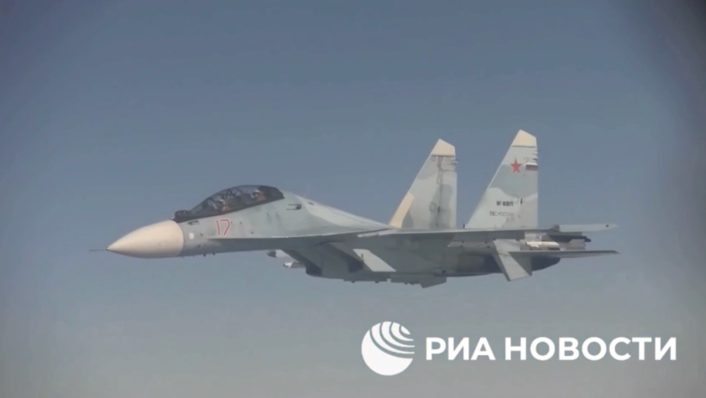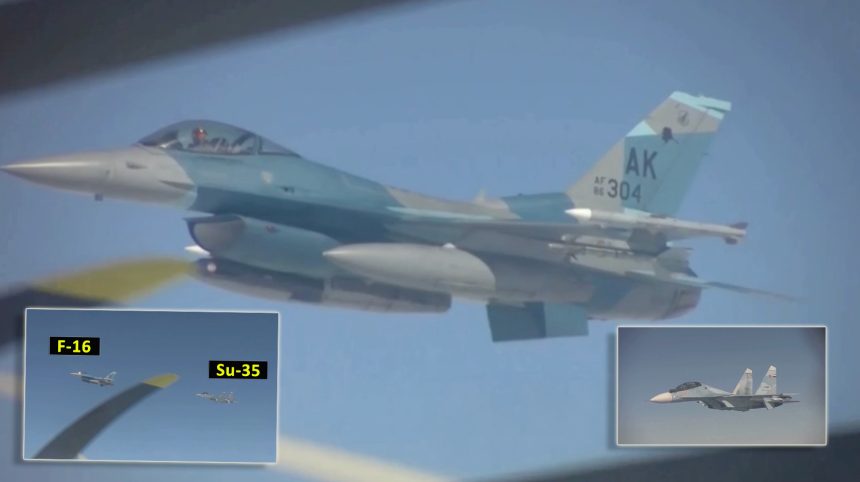A video taken from inside one of the Tu-95MS bombers shows one of the F-16s of the 18th FIS (sporting an Aggressor paint scheme) escorting the Bear bomber while chased by a Su-35S and Su-30SM.
On May 2, 2024, four Russian military aircraft flew inside the Alaska ADIZ (Air Defense Indentification Zone) and were intercepted by the U.S. Air Force.
“The North American Aerospace Defense Command (NORAD) detected and tracked four Russian military aircraft operating in the Alaska Air Defense Identification Zone (ADIZ) on May 2, 2024,” says a press release by NORAD.
“The Russian aircraft remained in international airspace and did not enter American or Canadian sovereign airspace. This Russian activity in the Alaska ADIZ occurs regularly and is not seen as a threat,” the release added.
While no additional details about the intercept were provided by NORAD, we know that the Russian bombers were escorted by at least an Su-35S and an Su-30SM during their mission thanks to a video filmed aboard one of the Tu-95MS and posted online by the Russian state-owned domestic news agency RIA Novosti.
According to the Russian MOD, the two Tu-95MS flew an 11-hour mission over the neutral waters of the Bering Sea near the western coast of Alaska, escorted by armed Flanker fighters and, “at certain stages of the route, the strategic missile carriers were accompanied by fighters from foreign countries”.
Indeed, the footage shows an F-16C of the 18th FIS (Fighter Interceptor Squadron) based at Eielson Air Force Base.
The unit, formerly 18th Aggressor Squadron, was the USAF’s dedicated Aggressor unit in Alaska, that was redesignated 18th FIS on Feb. 2, 2024, a designation that underscores the unit’s renewed focus on air defense, which has been going for a while now as the 18th AGRS complemented the F-22 in this role with a number of F-16 on Quick Reaction Alert duties since late 2022.
Interestingly, the short clip released by the Russians, shows the F-16C sporting a typical aggressors camouflage color scheme and carrying two AIM-120D AMRAAM and AIM-9L/M Sidewinder AAMs (Air-to-Air Missiles) along with a Sniper ATP (Advanced Targeting Pod), being chased by a Russian Su-35S armed with a pair of R-73A AAMs. There was almost certainly at least another F-16 not visibile in the video, as the QRA duty is carried out by a pair of aircraft. Still, it may happen, that for some reasons, the intercept is carried out by a single fighter.

Seconds later, the same footage shows the Su-30SM, also carrying two R-73A AAMs.

While this kind of close encounters happen every now and then, this one is particularly interesting, considering the mix of Russian types and the images of the F-16 of the recently redesignated 18th FIS in Aggressors paint scheme.
Air Defense Identification Zone
As explained in other articles, here at The Aviationist, there’s a significant difference between territorial sky and ADIZ.
The Air Defense Identification Zone (ADIZ) is a designated airspace surrounding a nation or part of it where strict identification, tracking, and control of aircraft are enforced for national security reasons. Aircraft flying within these zones without proper authorization may be intercepted by fighter aircraft on Quick Reaction Alert (QRA). ADIZ boundaries often extend beyond national airspace covering territorial waters, and while not defined by international law, any civil aircraft entering these zones is closely monitored and required to provide flight details for identification. Military aircraft not intending to enter national airspace are generally exempt from ADIZ procedures, but foreign military planes within ADIZ may be intercepted, identified, and escorted.
Conversely, a nation’s territorial sky refers to its sovereign airspace over both territorial land and waters, typically extending up to 12 nautical miles (NM) from the coastline.









